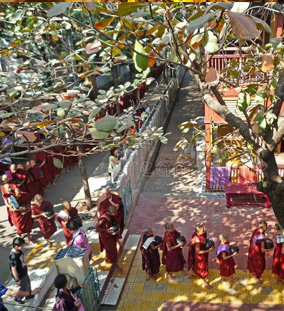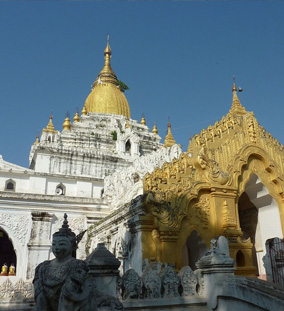




The Sanscript name Amarapura means "City of Immortality" although its life as Myanmar's capital was all too brief. King Bodawpaya initiated the move from Innwa in 1783 because he wanted to make a completely fresh start having acquired the throne through the brutal murder of his rivals and their families. The real intent might be that by moving the royal seat from Innwa to Amarapura, the other royal families would never be associated with the throne. In 1823 Innwa was restored as the seat of government and although in 1841 the throne returned to Amarapura, King Mindon made Mandalay the last capital of the Myanmar kings in 1857.
The main feature of the charming little town of Amarapura is its many workshops. From practically every house you can hear the clacking of the looms as they produce the most exquisite longyis (traditional sarong-style lower garment) of cotton or silk. There are many bronze foundries and woodcarvers providing devotional objects such as Buddha images and gongs for the lucrative market in nearby Mandalay. All that remains of the former royal palace are the stone ruins - the teak buildings were dismantled and taken away to Mandalay.
This magnificient monastery, founded in 1914, is one of Amarapura's main sights. This is one of the largest monasteries in Mandalay and at times there are more than 3,000 monks living and studying here. At 10:30 every morning hundreds of monks wait in long queues for their Swan (meals). At the same time, hordes of tourists stand watching and photographing them, and even in the refectory they cannot escape from the curious and often intrusive gaze of the visitors.
Nearby is the U Pein Bridge, which spans Taungthaman Lake, linking the village of that name with Amarapura. It was built between 1849 and 1851 by King Bagan, and at 1.2 kilometers is the longest teak bridge in the world. Early in the morning and late in the evening, it provides a popular atmosphere image for photographers. Pavilions and benches offer Myanmar travel visitors the chance to rest and give the local inhabitants an opportunity to sit and exchange information.
Crossing the bridge to Taungthaman village on the other side of the lake will bring you to Kyauktawgyi Pagoda (meaning 'pagoda of the Great Marble Image') which is also worth a visit. This too was built by King Bagan in 1847 and is thought to have been modelled on the Ananda Temple in Bagan. It houses a large figure of the Buddha in bright marble, as well as statues of his eighty eight pupils. The entrances are decorated with 19th century wall paintings depicting the signs of the zodiac and scenes from everyday life.